Erosion Mechanism of a Cavitating Jet on Groove Roughness
Abstract
:1. Introduction
2. Experimental Apparatus and Procedure
2.1. Experimental Setup
2.2. Shadowgraph and Schlieren Flow Visualizations
3. Results and Discussion
3.1. Erosion Behavior on Rough Wall
3.2. SEM Observations of Erosion Behavior
3.3. Shadowgraph Imaging of Cavitating Jet
3.4. Schlieren Imaging of Cavitating Jet
4. Conclusions
Author Contributions
Funding
Acknowledgments
Conflicts of Interest
Nomenclature
| D | depth |
| d | roughness height |
| f | focal length of lens |
| I | mean intensity of image |
| I’ | rms intensity of image |
| P | pressure |
| p | roughness pitch |
| Pv | vapor pressure |
| U | mean velocity |
| t | time after cavitating-jet injection |
| t’ | time |
| w | mass loss |
| x, y | coordinates (See Figure 4) |
| z | co-ordinate normal to wall |
| ρ | density of water |
| σ | cavitation coefficient (= 2(P − Pv)/ρU2) |
References
- Yamaguchi, A.; Shimizu, S. Erosion due to impingement of cavitating jet. J. Fluids Eng. 1987, 109, 442–447. [Google Scholar]
- Soyama, H.; Yanauchi, Y.; Sato, K.; Ikohagi, T.; Oba, R.; Oshima, R. High-speed observation of ultrahigh-speed submerged water jets. Exp. Therm. Fluid Sci. 1996, 12, 411–416. [Google Scholar]
- Sato, K.; Saito, Y. Unstable cavitation behavior in a circular-cylindrical orifice flow. JSME Int. J. Ser. B 2002, 45, 638–645. [Google Scholar]
- Franc, J.P.; Michel, J.M. Fundamentals of Cavitation; Kluwer Academic Publishers: Kluwer, The Netherlands, 2004. [Google Scholar]
- Hutli, E.A.F.; Nedeljkovic, M.S. Frequency in shedding/discharging cavitation cloud determined by visualization of a submerged cavitating jet. J. Fluids Eng. 2008, 130, 021304. [Google Scholar] [CrossRef]
- Fujisawa, N.; Fujita, Y.; Yanagisawa, K.; Fujisawa, K.; Yamagata, T. Simultaneous observation of cavitation collapse and shock wave formation in cavitating jet. Exp. Therm. Fluid Sci. 2018, 94, 159–167. [Google Scholar]
- Callenaere, M.; Franc, J.P.; Michel, J.-M.; Riondet, M. The cavitation instability induced by the development of a re-entrant jet. J. Fluid Mech. 2001, 444, 223–256. [Google Scholar]
- Dular, M.; Bachert, B.; Stoffel, B.; Sirok, B. Relationship between cavitation structures and cavitation damage. Wear 2004, 257, 1176–1184. [Google Scholar]
- Soyama, H. Enhancing the aggressive intensity of a cavitating jet by means of the nozzle outlet geometry. J. Fluids Eng. 2011, 133, 101301. [Google Scholar] [CrossRef]
- Sato, K.; Taguchi, Y.; Hayashi, S. High speed observation of periodic behavior in a convergent-divergent nozzle for cavitating water jet. J. Flow Contr. Meas. Vis. 2013, 1, 102–107. [Google Scholar]
- Hayashi, S.; Sato, K. Unsteady behavior of cavitating waterjet in an axisymmetric convergent-divergent nozzle; High speed observation and image analysis based on frame difference method. J. Flow Contr. Meas. Vis. 2014, 2, 94–104. [Google Scholar]
- Stanley, C.; Barber, T.; Rosengarten, G. Re-entrant jet mechanism for periodic cavitation shedding in a cylindrical orifice. Int. J. Heat Fluid Flow 2014, 50, 169–176. [Google Scholar]
- Dular, M.; Petkovsek, M. On the mechanisms of cavitation erosion–Coupling high speed videos to damage patterns. Exp. Therm. Fluid Sci. 2015, 68, 359–370. [Google Scholar]
- Watanabe, R.; Kikuchi, T.; Yamagata, T.; Fujisawa, N. Shadowgraph imaging of cavitating jet. J. Flow Contr. Meas. Vis. 2015, 3, 106–110. [Google Scholar]
- Peng, G.; Okada, K.; Yang, C.; Oguma, Y.; Shimizu, S. Numerical simulation of unsteady cavitation in a high-speed water jet. Int. J. Fluid Mach. Syst. 2016, 9, 66–74. [Google Scholar]
- Watanabe, R.; Yanagisawa, K.; Yamagata, T.; Fujisawa, N. Simultaneous shadowgraph imaging and acceleration pulse measurement of cavitating jet. Wear 2016, 358–359, 72–79. [Google Scholar]
- Fujisawa, N.; Kikuchi, T.; Fujisawa, K.; Yamagata, T. Time-resolved observations of pit formation and cloud behavior in cavitating jet. Wear 2017, 386–387, 99–105. [Google Scholar]
- Fujisawa, N.; Horiuchi, T.; Fujisawa, K.; Yamagata, T. Experimental observation of the erosion pattern, pits, and shockwave formation in a cavitating jet. Wear 2019, 418–419, 265–272. [Google Scholar]
- Wang, Y.-C.; Chen, Y.-W. Application of piezoelectric PVDF film to the measurement of impulsive forces generated by cavitation bubble collapse near a solid boundary. Exp. Therm. Fluid Sci. 2007, 32, 403–414. [Google Scholar]
- Franc, J.-P.; Riondet, M.; Karimi, A.; Chahine, G.L. Impact load measurements in an erosive cavitating flow. J. Fluids Eng. 2011, 133, 121301. [Google Scholar] [CrossRef]
- Plesset, M.S.; Chapman, R.B. Collapse of an initially spherical vapor cavity in the neighborhood of a solid boundary. J. Fluid Mech. 1971, 47, 283–290. [Google Scholar]
- Lauterborn, W.; Bolle, H. Experimental investigations of cavitation bubble collapse in the neighborhood of a solid boundary. J. Fluid Mech. 1975, 72, 391–399. [Google Scholar] [CrossRef]
- Fujikawa, S.; Akamatsu, T. Experimental investigations of cavitation bubble collapse by a water shock tube. Bull. JSME 1978, 21, 223–230. [Google Scholar] [CrossRef]
- Shima, A.; Takayama, K.; Tomita, Y.; Miura, N. An experimental study on effects of a solid wall on the motion of bubbles and shock waves in bubble collapse. Acta Acust. United Acust. 1981, 48, 293–301. [Google Scholar]
- Vogel, A.; Lauterborn, W.; Timm, R. Optical and acoustic investigations of the dynamics of laser-produced cavitation bubbles near a solid boundary. J. Fluid Mech. 1989, 206, 299–338. [Google Scholar] [CrossRef]
- Lindau, O.; Lauterborn, W. Cinematographic observation of the collapse and rebound of a laser- produced cavitation bubble near a wall. J. Fluid Mech. 2003, 479, 327–348. [Google Scholar] [CrossRef]
- Wang, Y.-C.; Huang, C.-H.; Lee, Y.-C.; Tsai, H.-H. Development of a PVDF sensor array for measurement of the impulsive pressure generated by cavitation bubble collapse. Exp. Fluids 2006, 41, 365–373. [Google Scholar] [CrossRef]
- Numachi, F.; Oba, R.; Chida, I. Effect of surface roughness on cavitation performance of hydrofoils, Rep.1. J. Basic Eng. 1965, 87, 495–502. [Google Scholar] [CrossRef]
- Ahmed, S.M.; Hokkirigawa, K.; Oba, R.; Kikuchi, K. SEM observation of the vibratory cavitation; Fracture mode during the incubation period and the small roughness effect. JSME Int. J. 1991, 34, 298–303. [Google Scholar] [CrossRef] [Green Version]
- Chiu, K.Y.; Cheng, F.T.; Man, H.C. Evolution of surface roughness of some metallic materials in cavitation erosion. Ultrasonics 2005, 43, 713–716. [Google Scholar] [CrossRef]
- Lin, J.; Wang, Z.; Cheng, J.; Kang, M.; Fu, X.; Hong, S. Effect of initial surface roughness on cavitation erosion resistance of arc-sprayed Fe-based amorphous/nanocrystalline coatings. Coatings 2017, 7, 200. [Google Scholar] [CrossRef] [Green Version]
- Altay, R.; Sadaghiani, A.K.; Sevgen, M.I.; Sisman, A.; Kosar, A. Numerical and experimental studies on the effect of surface roughness and ultrasonic frequency on bubble dynamics in acoustic cavitation. Energies 2020, 13, 1126. [Google Scholar] [CrossRef] [Green Version]
- Soyama, H. Effect of nozzle geometry on a standard cavitation erosion test using a cavitating jet. Wear 2013, 297, 895–902. [Google Scholar] [CrossRef]
- Settles, G.S. Schlieren and Shadowgraph Techniques, Visualizing Phenomena in Transparent Media; Springer Science & Business Media: Berlin/Heidelberg, Germany, 2012; pp. 111–122. [Google Scholar]
- Fujisawa, K.; Yamagata, T.; Fujisawa, N. Liquid droplet impingement erosion on groove roughness. Nucl. Eng. Des. 2018, 330, 368–376. [Google Scholar] [CrossRef]
- Fujisawa, K.; Ohki, M.; Fujisawa, N. Influence of surface roughness on liquid droplet impingement erosion. Wear 2019, 432–433, 202955. [Google Scholar] [CrossRef]
- Fujisawa, N.; Komatsu, M.; Yamagata, T. Experimental study on erosion initiation via liquid droplet impingement on smooth and rough walls. Wear 2020, 452–453, 203316. [Google Scholar] [CrossRef]
- Fujisawa, N. Liquid droplet impingement erosion on multiple grooves. Wear 2020, 462–463, 203513. [Google Scholar] [CrossRef]
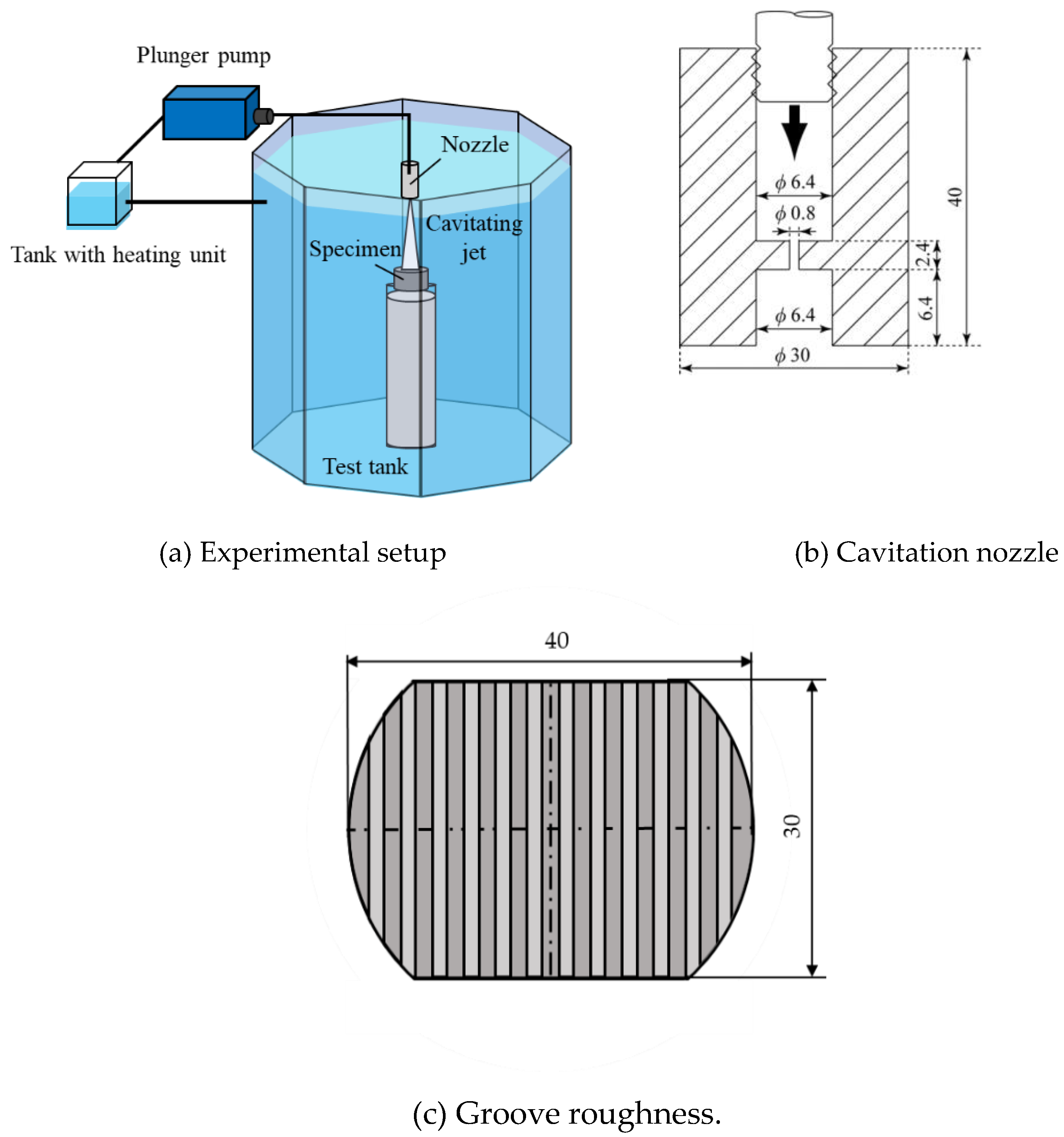
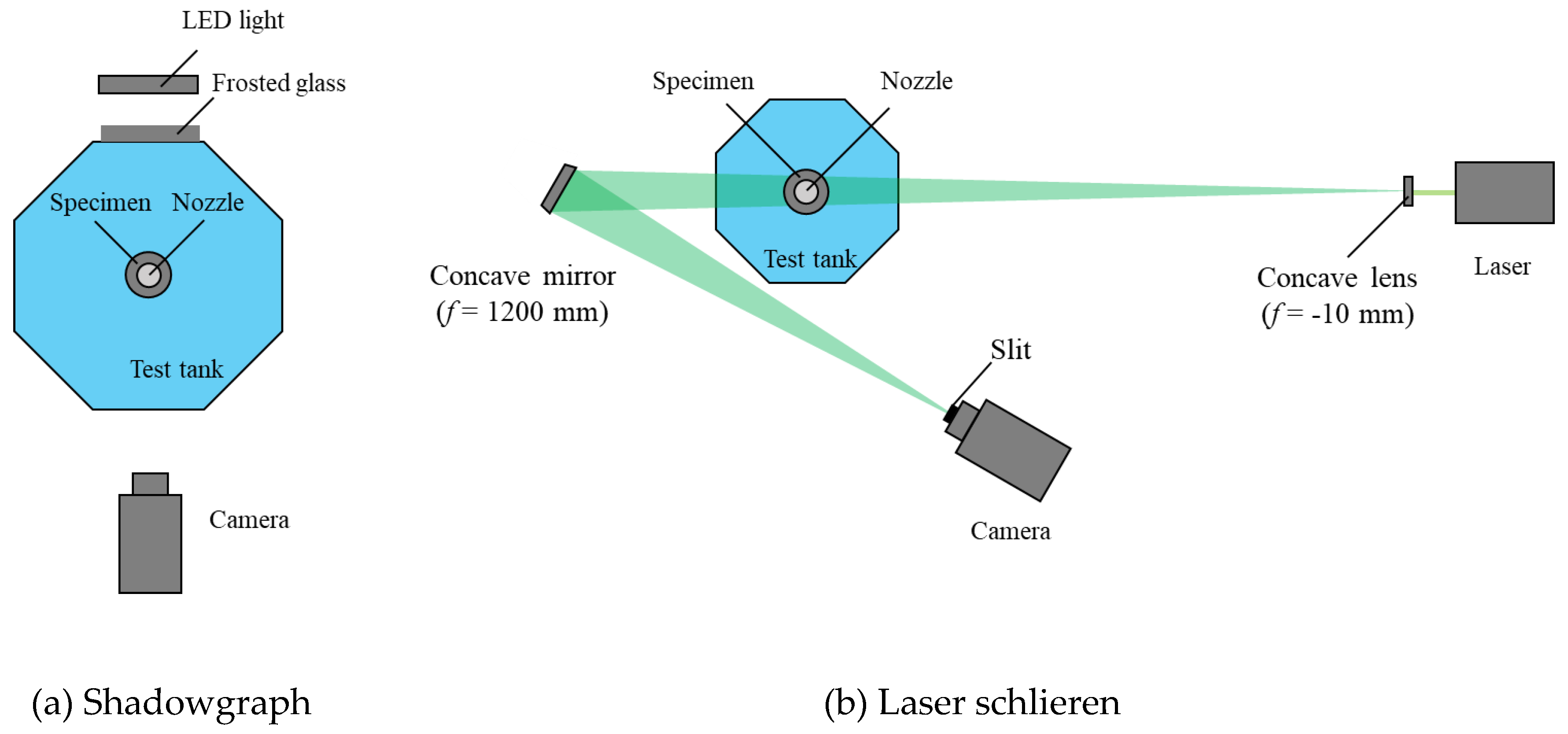
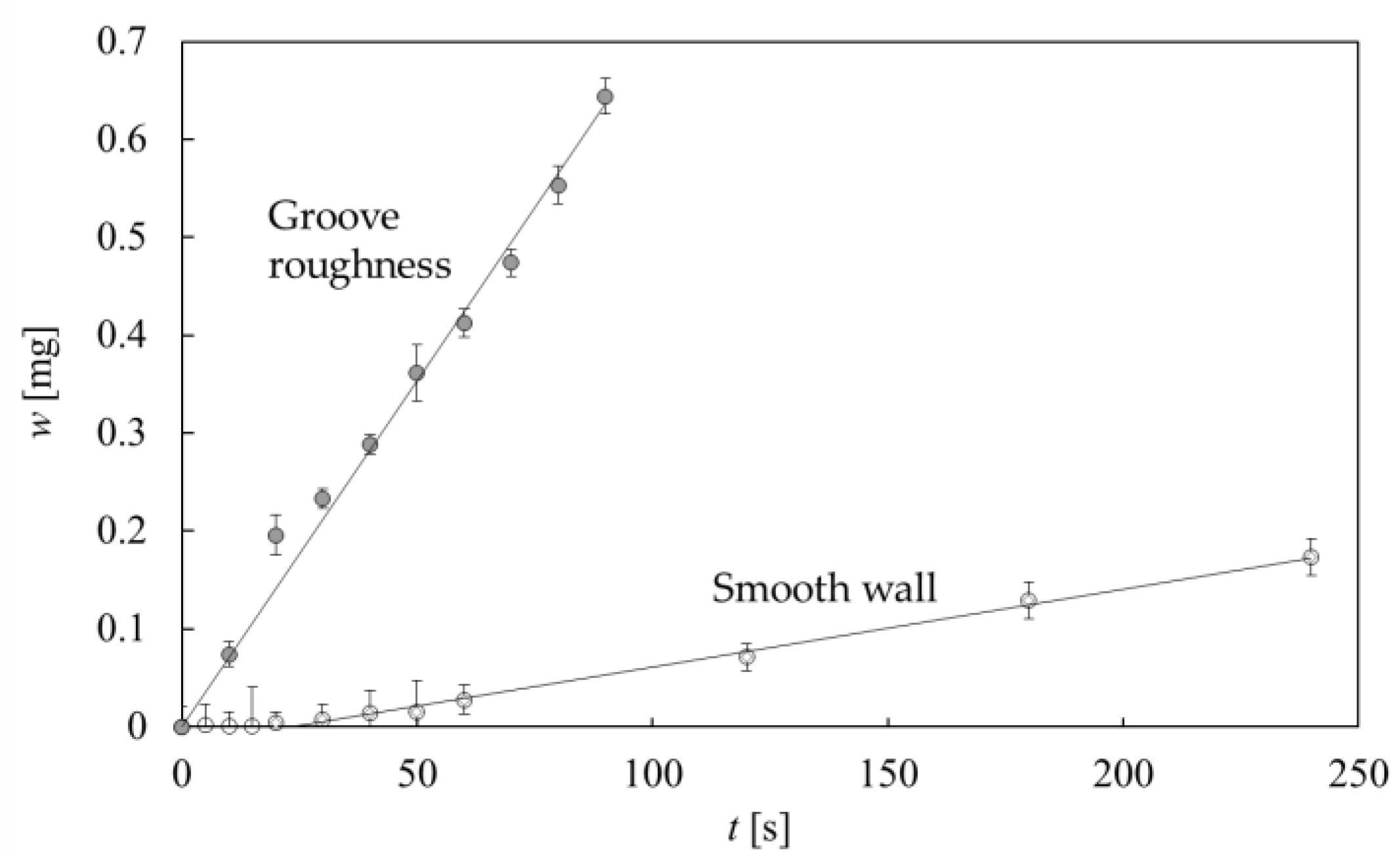


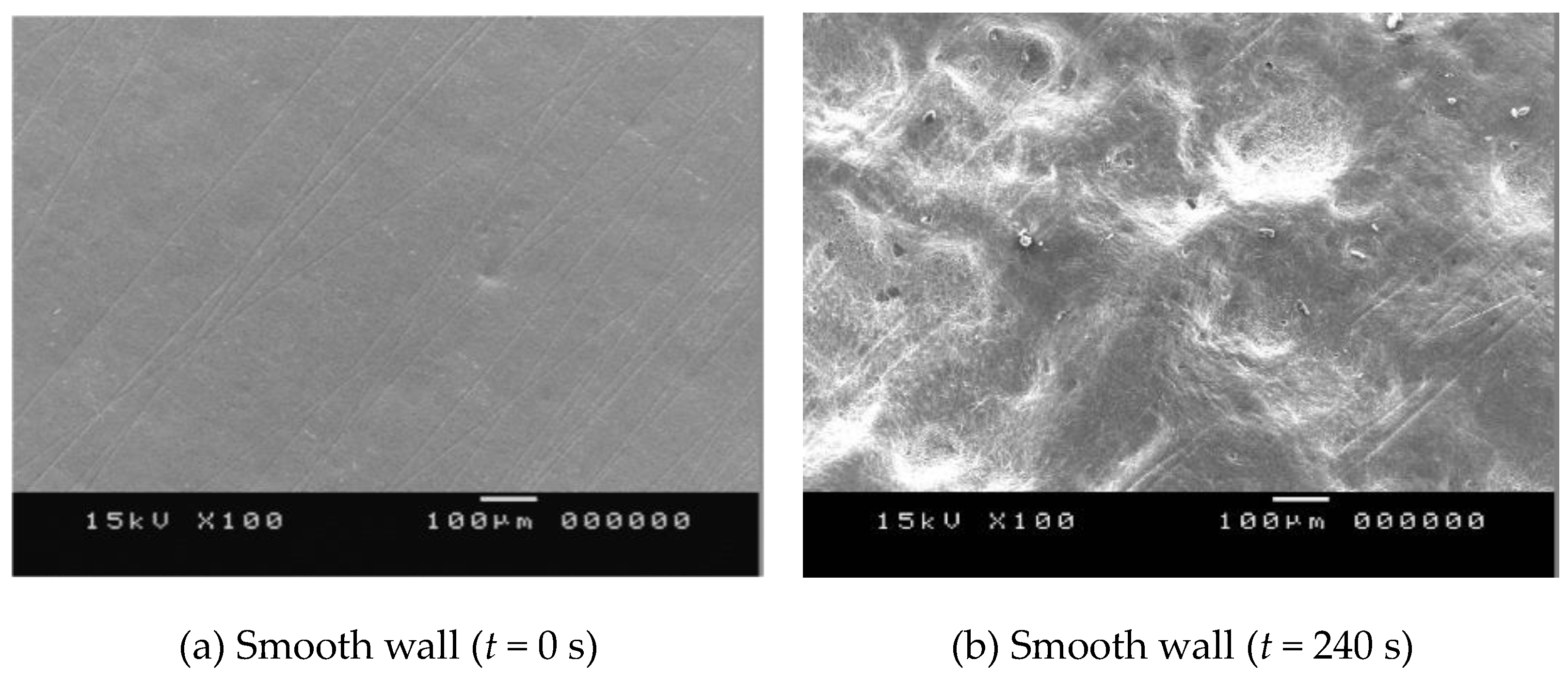
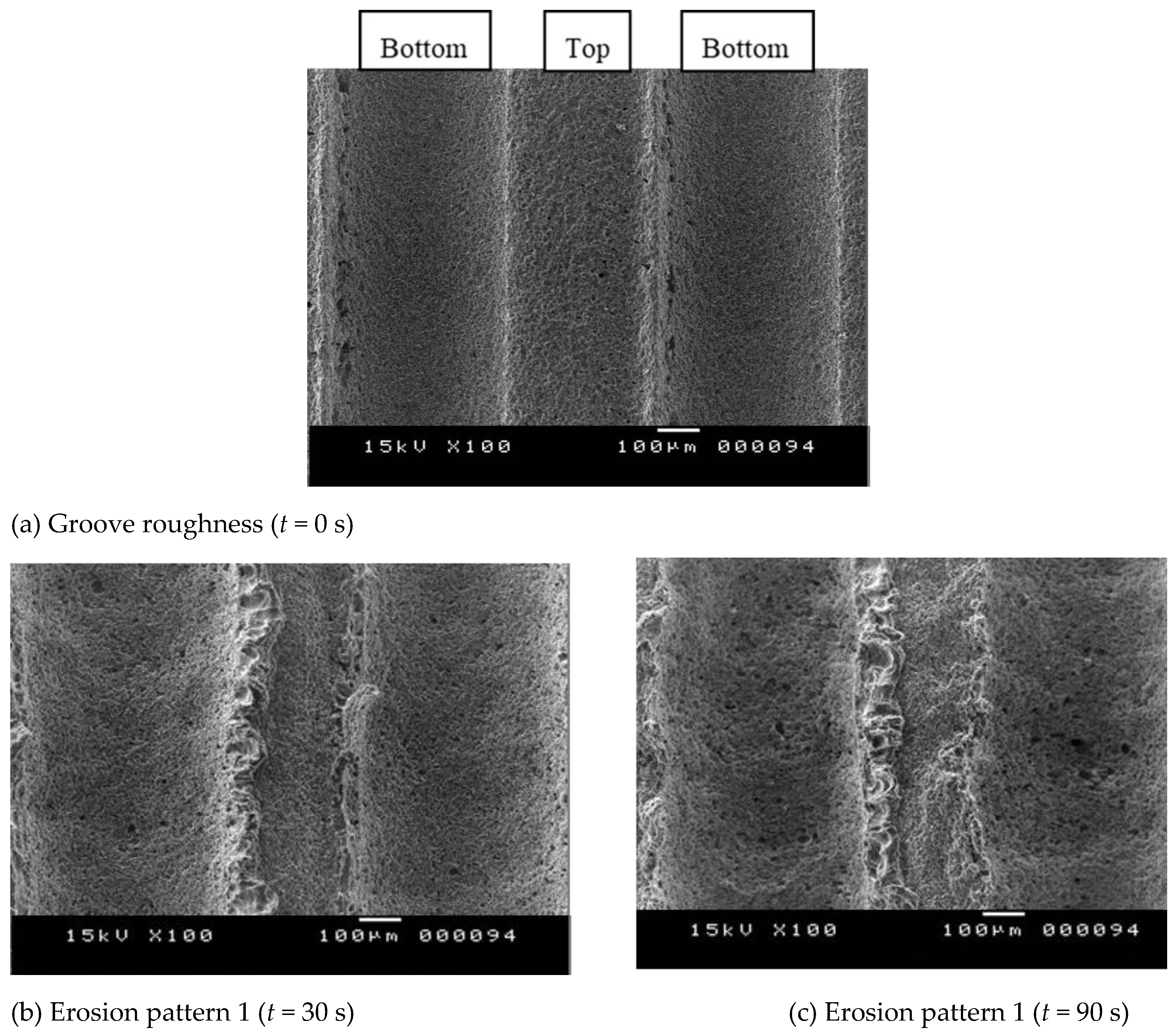

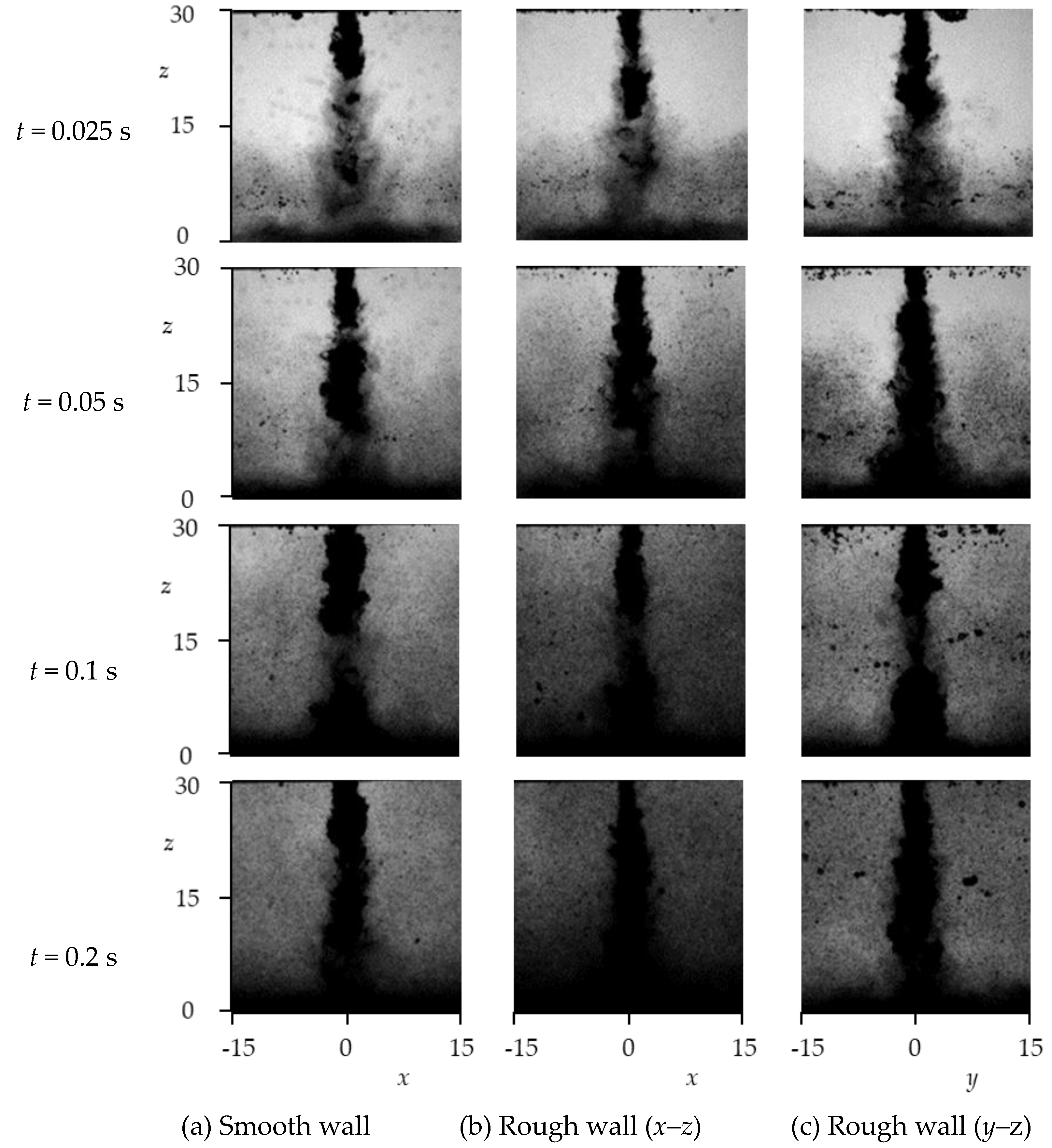

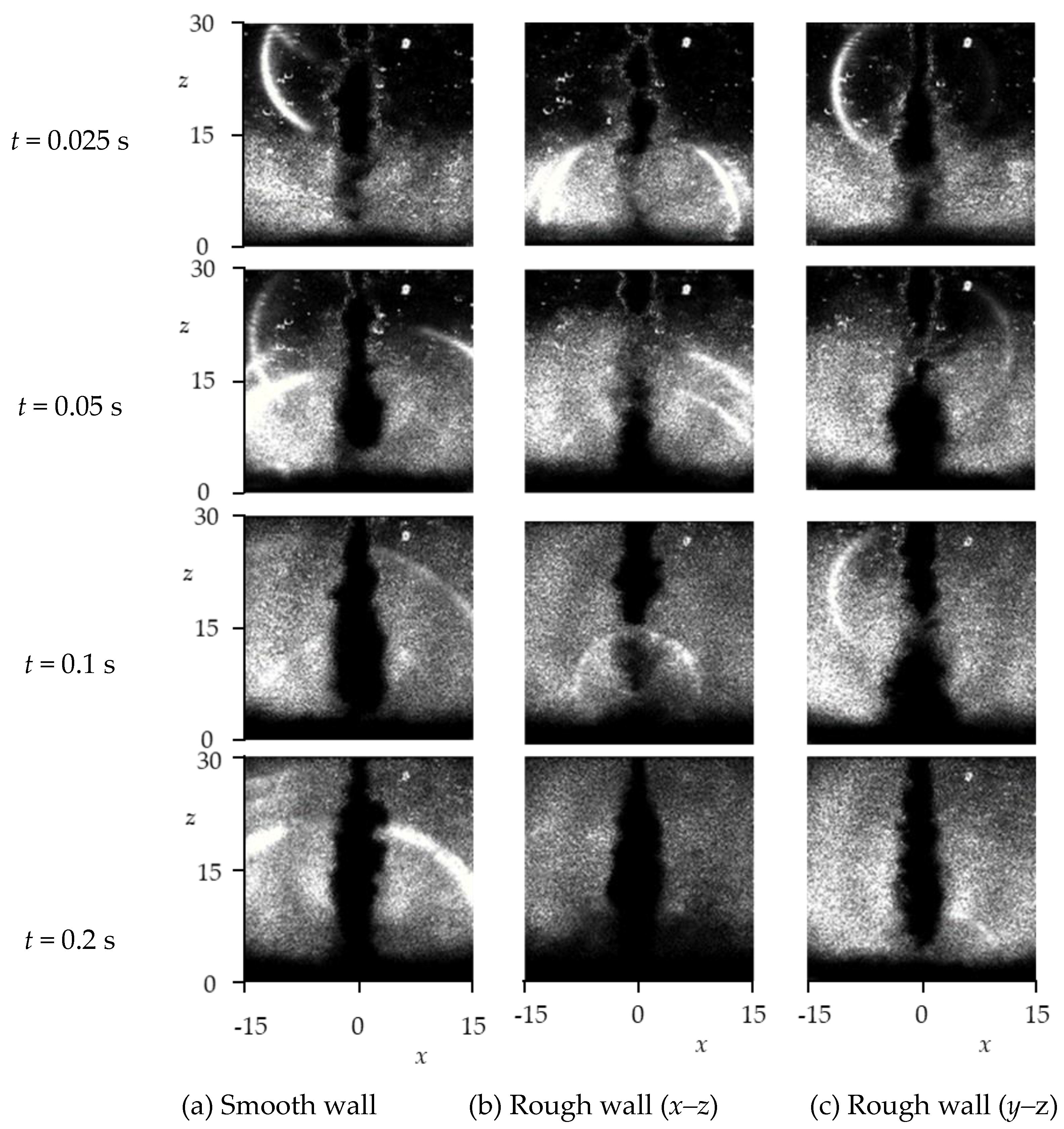
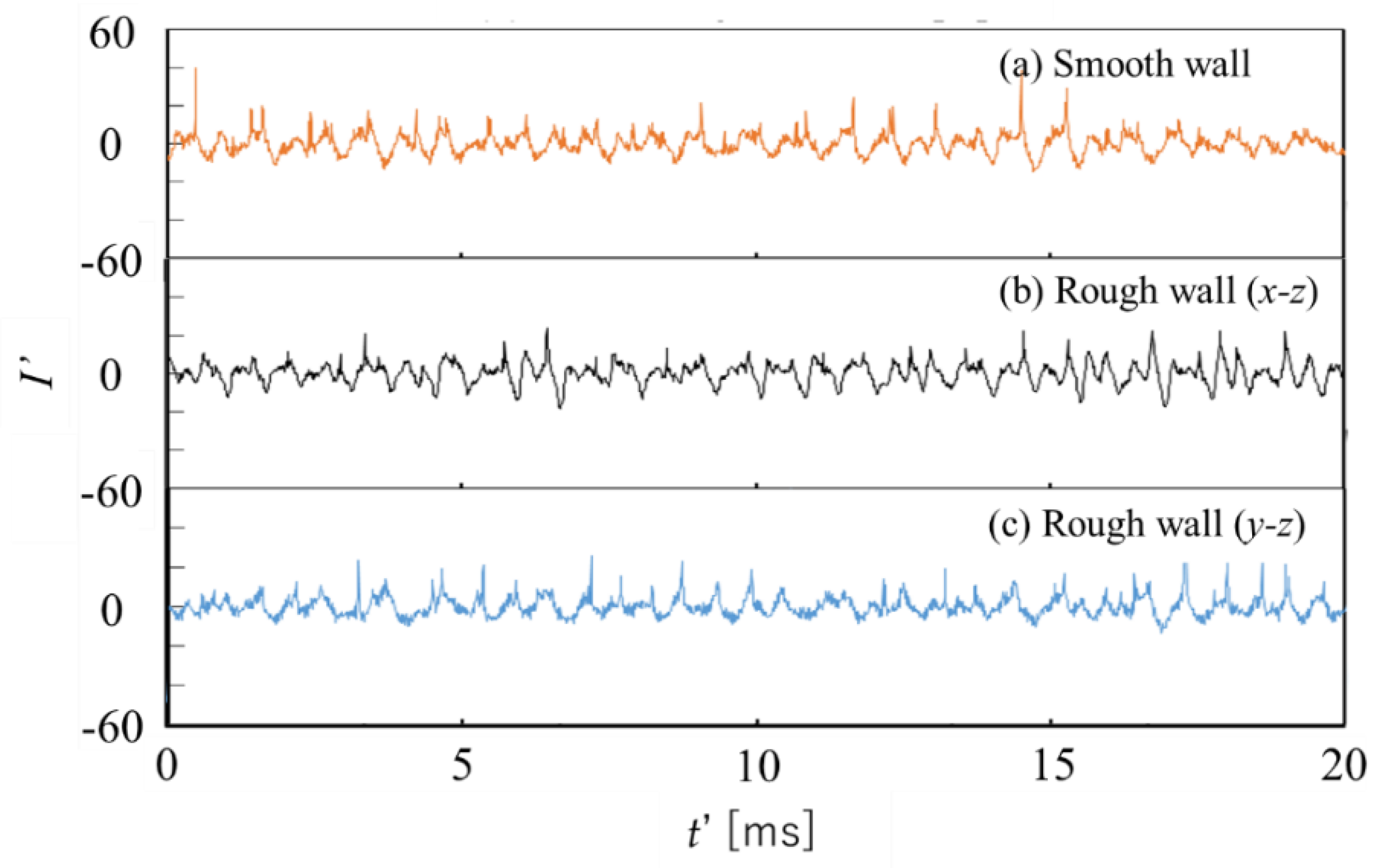
Publisher’s Note: MDPI stays neutral with regard to jurisdictional claims in published maps and institutional affiliations. |
© 2020 by the authors. Licensee MDPI, Basel, Switzerland. This article is an open access article distributed under the terms and conditions of the Creative Commons Attribution (CC BY) license (http://creativecommons.org/licenses/by/4.0/).
Share and Cite
Fujisawa, N.; Yamagata, T.; Seki, R.; Ohki, M. Erosion Mechanism of a Cavitating Jet on Groove Roughness. Fluids 2021, 6, 6. https://doi.org/10.3390/fluids6010006
Fujisawa N, Yamagata T, Seki R, Ohki M. Erosion Mechanism of a Cavitating Jet on Groove Roughness. Fluids. 2021; 6(1):6. https://doi.org/10.3390/fluids6010006
Chicago/Turabian StyleFujisawa, Nobuyuki, Takayuki Yamagata, Ryotaro Seki, and Motofumi Ohki. 2021. "Erosion Mechanism of a Cavitating Jet on Groove Roughness" Fluids 6, no. 1: 6. https://doi.org/10.3390/fluids6010006




